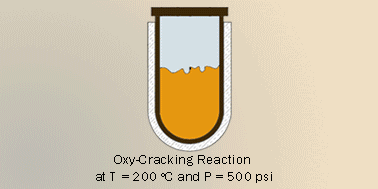Experimental and theoretical studies on oxy-cracking of Quinolin-65 as a model molecule for residual feedstocks†
Abstract
Oxy-cracking is a combination of oxidation and cracking reactions for converting heavy hydrocarbons into commodity products with minimal emission of CO2. This reaction takes place in basic aqueous media, at mild operation temperatures (200–230 °C) and pressures (500–750 psi). In this study, the main goal is to understand the oxy-cracking mechanism, involving oxidation and cracking reactions, of solid hydrocarbons represented by the model molecule Quinolin-65 (Q-65). In the experimental part, the oxy-cracking reaction was performed in a Parr batch reactor operated at an optimized oxygen partial pressure of 750 psi and temperatures between 200 °C and 230 °C. The reaction products were characterized by FTIR spectroscopy, TOC analysis, GC, NMR spectroscopy, and XPS. We found that the main products are composed of organic carboxylic, phenolic, and carbonyl-containing compounds, with small amounts of inorganic carbon (IC). In the theoretical part of the study, a comprehensive computational modeling of Q-65 reactivity was performed using high-level quantum theoretical calculations. The reaction studies indicated the attack of the hydroxyl radical (OH˙) and hydroxide anion (OH−) on the Q-65 molecule. The theoretical study employed the density functional theory (DFT) and the second-order Møller–Plesset perturbation theory (MP2) to study the reaction mechanisms under the same experimental conditions. Both the theoretical and the experimental studies confirmed the complexity of the reaction kinetics. The reaction kinetic results suggested that the Q-65 oxy-cracking reaction went through a parallel-consecutive reaction in which oxidative decomposition took place in the first step producing different aromatic intermediates. These intermediates were oxy-cracked consecutively into different organic acids and a small amount of CO2 gas.



 Please wait while we load your content...
Please wait while we load your content...